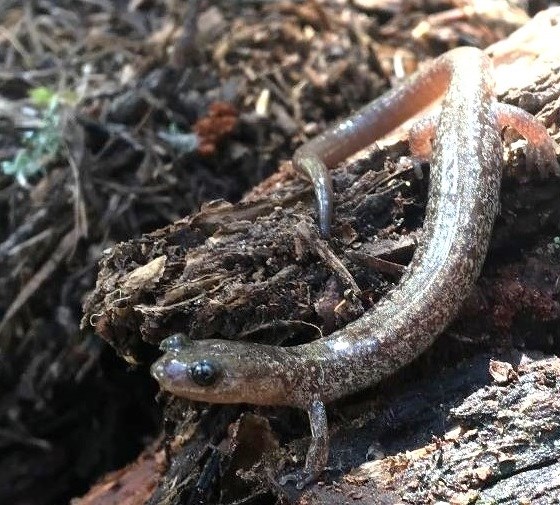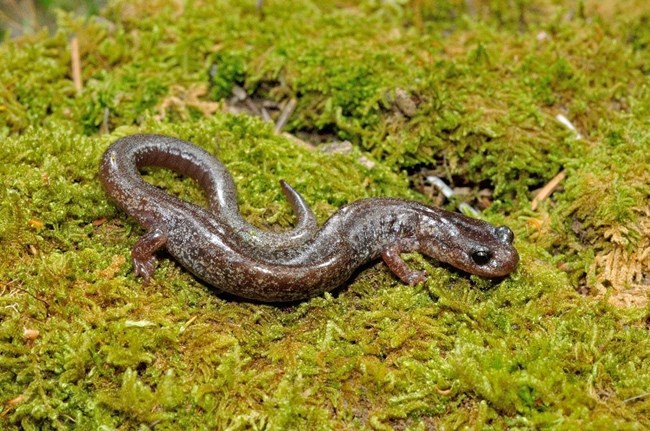Part of a series of articles titled NRCA 2022: Condition of Valles Caldera’s Natural Resources and Scenic Views.
Article
An Endangered Amphibian on an Active Volcano: the Jemez Mountains Salamander at Valles Caldera
Valles Caldera National Preserve is one of the largest fully protected areas throughout this species’ historical range, and the preserve contains 26% of the critical habitat identified for the species. The preserve is named for the 13-mile-wide, circular depression known as the Valles Caldera, created about 1.25 million years ago when the volcano erupted. Geologists consider the volcano to still be active (although it is currently dormant).
The Jemez Mountains salamander: a secretive and mostly underground animal
-
The salamander is secretive, and many aspects of its ecology, especially reproduction, are poorly understood.

© Nancy Karraker
-
It belongs to a family, or group, of amphibians that is strictly terrestrial, which means that it does not need standing water for any part of its life cycle. This is unlike most other amphibians!
-
It lives most of the year underground. Surveying the salamander is challenging because whether salamanders emerge from their below-ground environment depends on soil moisture and air temperature, which changes annually, seasonally, and daily. The salamander usually surfaces after late summer rains saturate the soil and air temperatures average 55 °F.
-
The salamander occurs primarily in mixed-conifer forests with well-developed understories and moist soils. Its habitat has course, woody debris and rocky soil with spaces that allow for salamanders to move horizontally and vertically below the surface.
What are the biggest threats to Jemez Mountains salamanders?
The U.S. Fish and Wildlife Service listed the species as endangered because of significant threats to its persistence, which include:
- altered fire regimes. Historical fire exclusion and suppression lead to more severe fire events; this is the main threat to salamander habitat but may also kill individual salamanders.
- recreational activities. The Jemez Mountains are heavily used for recreation (including mountain biking, hiking, camping, skiing, and off-highway [motorized] vehicle use), and these activities and their related infrastructure may affect individual salamanders and their habitat.
- potential susceptibility to a disease, chytridiomycosis (or chytrid). This disease is caused by a fungus and has led to major population declines in amphibians worldwide; whether the fungus causes chytrid in the Jemez Mountains salamander is unknown.
Assessing conditions of Jemez Mountains salamanders at Valles Caldera
A recent Natural Resource Condition Assessment (NRCA) through the NPS NRCA Program focused on seven resources in the park, including Jemez Mountains salamanders. NRCAs evaluate natural resource conditions so that parks can use the best available science to manage their resources. Due to the limited amount of information available on this species in the preserve, ecologists at Utah State University:
- summarized what is known about the salamander in the preserve and surrounding area,
- summarized current research projects on the salamander in the preserve and preserve vicinity, and
- identified potential indicators of salamander condition for future study and monitoring.
What did we learn?

© Chris Cirrincione
- Many areas where the salamanders were present historically are now unoccupied, and those that continue to be occupied support fewer individuals. However, unoccupied areas warrant further survey to confirm absence due to the salamander’s low rate of detection.
- About 350 salamanders were recorded in and around the preserve in 1992, after which observations fell dramatically to only a handful a year in recent years.
- Combined, two extensive, severe wildfires in the preserve (in 2011 and 2013) burned the majority of areas where salamanders had been observed in the past. Not only did these fires probably lead to direct mortality of salamanders, they also destroyed suitable habitat.
- Utah State University ecologists suggested four indicators of Jemez Mountains salamander condition for a future study/condition assessment—habitat and connectivity (area of suitable habitat, and distance between suitable habitat patches), occupancy (proportion of suitable habitat patches occupied), demography (population size, and proportion of subadult to adult salamanders), and health status (disease prevalence).
Ongoing studies
Surveying/studying the Jemez Mountains salamander is difficult because of the species’ life history and sensitivity to disturbance. However, studies by outside researchers, in and around Valles Caldera, have occurred and are ongoing. These studies are providing important information on the status of the species in the preserve and throughout its range. A study by Dr. Nancy Karraker, Laboratory of Applied Conservation Biology, University of Rhode Island is:
-
outfitting salamanders with passive integrated transponders (PIT-tags), which will help researchers understand underground versus aboveground habitat use and correlate it with temperature and precipitation.
-
surveying historical sites and potential sites and identifying areas for restoration. Good news! The researcher located salamanders in two canyons where there had been no observations since the 1980s, and she saw a female with eggs and a female/male pair, which confirms breeding in and around the preserve.
What can park managers do with this information?
This NRCA study reviewed and summarized the available information on the Jemez Mountains salamander, and it’s clear the park needs additional information on this species. The NRCA suggested four potential indicators for use in a future condition assessment (once more data are available). Additional data on the species will also aid in the development of a fine-scale habitat map, which would help managers to target survey efforts and monitor the status of the species.
Information in this article was summarized from: Albright J, Struthers K, Baril L, Brunson M. 2022. Natural resource conditions at Valles Caldera National Preserve: Findings & management considerations for selected resources. Natural Resource Report. NPS/VALL/NRR—2022/2409. National Park Service. Fort Collins, Colorado. https://doi.org/10.36967/nrr-2293731
Read More about the 2022 Valles Caldera NRCA Project >
Visit the NRCA Program Home>
Last updated: January 12, 2023
